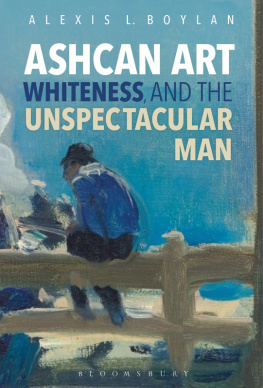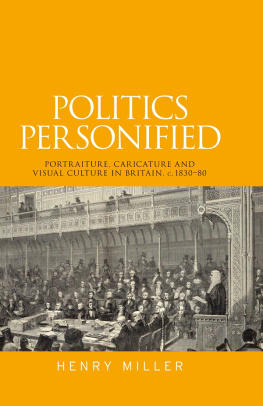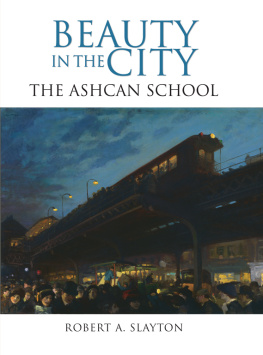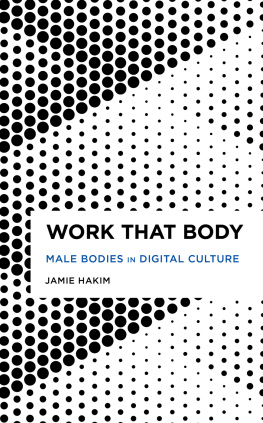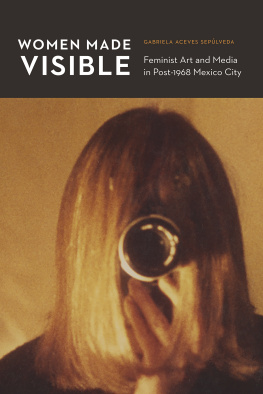Ashcan Art, Whiteness, and
the Unspectacular Man
Ashcan Art, Whiteness, and the
Unspectacular Man
Alexis L. Boylan
Bloomsbury Academic
An imprint of Bloomsbury Publishing Inc

For Bellina Bobo Farbman who taught me to look carefully and thoughtfully and then to love carelessly and with abandon.
Figures
Plates
Every year as I watch the Academy Awards, I am always a little baffled at how difficult it seems for professional thespians to clearly and with a bit of charm thank those people who got them to that stage. Why all the tears? Why all the stammering? Why can they not remember people and then get off the stage? I will not be so judgmental next time I watch. The process of writing acknowledgments is deeply humbling as it is overwhelming to sit down and really think about how many people were so generous with their time, attention, love, and yes, money. The debts I owe for this book are, quite frankly, obscene. So, please imagine I am saying this all stammering, with tears in my eyes. I cannot be clever now, and everything I write sounds trite, but I hope somehow you can feel my deep, profound gratitude.
I want to begin by thanking my editor Margaret Michniewicz. Her calm hand, steady guidance, and good humor made the process of moving this book from one stage to the next dreamy. The outside readers and the team at Bloomsbury also helped vastly improve the content and aided in this process; I am appreciative of their time and talent. This project was supported by several institutional fellowships and grants. The first chapter was researched and written at the Newhouse Humanities Center at Wellesley College; the colleagues I worked with during my time there offered smart, sharp insights and made my time productive. This project also had support from faculty and travel funds at Lawrence University and the University of Tennessee, Knoxville (UTK). I then had the good fortune to receive a small faculty grant and support from the Fund for Interdisciplinary Research Endeavors of the University of Connecticut (UConn). A grant from the Womens, Gender, and Sexuality Studies Program at UConn financed the color images published here, and I am truly grateful for this significant support. Finally, Heather Campbell Coyle and Rachael DiEleuterio at the Delaware Art Museum deserve my special thanks. They have answered my myriad phone calls, emails, and research visits with good cheer and steady advice. Michael Young at UConn likewise tracked down so many citations I could not findhe is a magician.
This book came with me to three institutions, so I thank my art and art history colleagues and students at Lawrence and UTK. I also want to recognize the contemporary arts reading group at UTK, who helped build a community devoted to critically engaging in the arts, in particular Ben Lee, Amy Elias, and Jered Sprecher. Moving to UConn and finishing this book would not have been possible without the work and resourcefulness of Manisha Desai, Nancy Naples, Shirley Roe, Jeremy Teitelbaum, Judith Thorpe, and David Woods. As a joint appointment in the Art and Art History Department and the Womens, Gender, and Sexuality Studies Program, I have been the beneficiary of smart, committed, generous, and kind colleagues. I am in constant awe of their goodwill, talent, and hard work. A special shout-out goes to the art history team: Anne DAlleva, Kelly Dennis, Jean Givens, Robin Greeley, Margo Machida, and Michael Orwicz. I adore you all and thank you for being so welcoming and encouraging. Your friendship made this process much easier. I also had the good luck to be included in a writing group who were cruel to be kind in the right measure; thanks to Martha Cutter, Anne Mae Duane, Michael Gill, Kathy Knapp, and Shawn Salvant. Toni-Marie LaFollette, Debbie Cooper, and Coleen Spurlock also helped me with dozens of tasks and offered a million kindnesses.
Officially, I think the following people are mentors but as is the nice aspect of this profession, those who start off teaching you how to do footnotes, how to research, and how to act in a job interview become your friends. Matthew Baigell is my model as a scholar, teacher, and person. Everything I write is a reflection of the kind of critical and empathic scholar he encouraged me to be. I hope this book in some small way honors his impact. Martin Eidelberg and Carla Yanni pushed me to think harder and write better; not a week goes by when I do not either take advice they gave me, or deliver it to students. Thayer Tolles has likewise helped me to find my voice, but just as importantly, she taught me to listen hard, specifically to the object itself. I also want to recognize Joyce Schiller who I miss terribly. She would have argued with every conclusion I came to in this book, and I am sorry we did not get to talk about it all and then go out to lunch and laugh.
The Ashcan men had a circle and I like to think I do as well. These people have given love and friendship, advice and solace, pep talks, and happy distraction. First off, I want to thank Ethan Seidman, who helped me find myself and this project again. Thanks then to Julia Alderson, Sharon Matt Atkins, Christopher Atkins, Viola Augustin, John Bagwell, Brian Bishop, Emily Bivens, Gina Bloom, Nina Dayton, Cora Lynn Deibler, Joe DUva, Clare Eby, Betsy Fahlman, Diane Fox, Danny Geller, Kim Gilmore, Barbara Gurr, Merrily Harris, William Harris, Kate Haulman, Gabriela Jasin, Brendan Kane, Elizabeth Lee, Tom Lutte, Michael Lynch, Beauvais Lyons, Chris Molinski, Guy Nelson, Matthew Nichols, Ashley Oates, Michael Orr, Janet Pritchard, Rebecca Segal, Cathy Schlund-Vials, Leslie Starritt, Patricia Tinajero, Chris Vials, Alan Wallach, Ken Wissoker, and Edvin Yegir. Each of you deserves a paragraph, a page, a chapter of praise.
Much love to my wonderful parents and their spouses: James Boylan, Jo Ann Boylan, Llyena Boylan Spieth, and Donald Spieth. They listened without judgment, always seemed excited about the project, and showered me with outsized and unearned praise. In other words, they aided my delusions, which is what good, loving parents do. Gabriel Boylan and his wife Christine Smallwood, and Nicko Boylan have also lived with this project for a long time. I appreciate their patience and willingness to hear me yammer about Ashcan-this and Ashcan-that. Gabe also read this book several times over and always responded to my emergency emails and texts with calm, critical, and encouraging input. Thank you. My in-laws Michael and Cindy McElya, and my brother-in-law and sister-in-law Jim and Kara McElya have likewise offered love and support at each step. Anne Kolker and Cliff and Martie Karlovsky are impossibly generous and much is owed to them. Sweet Ruby also needs to be given her props; she read no drafts but reminded me to be attentive and open to the love and happiness of the day. Finally, all my love to Micki McElya. You are my love, my saving grace. I do not know how I got so lucky, but it is my great fortune and honor to walk through this life with you.
How does one become something without becoming a thing?
Hilton Als (2014)
In William Glackenss Skating Rink, New York City, c. 1906 (). These men perform for our benefit, to be watched and to be consumed. Yet, in opening up these compositional spaces, Glackens verifies not their visibility but a seemingly stark and lonely contrast: each mans performance is overshadowed and lost in the hustle of the crowd. Glackens gives the viewer enough visual information to see their desire to be seen and to see this desire deniedthe thrust of bodies the painter pushes around the rink overpowering any individual authority, beauty, or spectacle. This disconnect, offering up the male body only to deny the viewer any kind of knowledge, narrative, or satisfaction, is typical of Glackens and the work of the Ashcan Circle.
Next page
